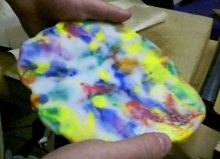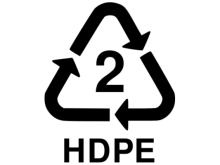HDPE Recycling - Tutorial
By Mike on Saturday, December 8, 2012, 23:54 - Permalink
 Several projects on this site have made use of recycled plastic - so I thought it was about time I documented the recycling process in video form.
Several projects on this site have made use of recycled plastic - so I thought it was about time I documented the recycling process in video form.
The Source Material
 HDPE is used to make a variety of household items - including bottles or containers for food, drinks, cleaning products and toiletries.
HDPE is used to make a variety of household items - including bottles or containers for food, drinks, cleaning products and toiletries.
Many such containers are now marked with the standard resin identification symbols like this one - which although supposedly standardised, sometimes appears as variants with '02' in the centre and/or 'PE-HD' underneath, or without any text underneath the triangular arrows at all.
Frequently Asked Questions
Q: Can't I just melt it into a pourable Liquid?
A: Not really - when melted, it's more of a toffee-like consistency than a flowing liquid. In industrial processes, this matters little, as it is moulded under pressure. It will become less viscous as the temperature increases, but the risk of burning it also increases - at best, this may weaken the polymer and at worst, it could produce toxic or explosively flammable fumes.
Q: What about melting it in a pan?
A: Again, the risk of burning it is high - the thermal insulating properties of HDPE mean that by the time the material in the middle is melted, the bottom layer, in contact with the heat source, will be too hot. Also, be prepared to throw away the pan, as the solidified remains won't come off.
Q: How easy is it to mould into shape?
A: When melted in the way shown in the video, there is perhaps a minute of working time before it has hardened and set - in theory, that's enough time to form it into shape in a mould, however, there are a few factors to consider:
- It will be hot - Way hotter than boiling water, which means it needs to be handled using gloves, tongs etc - this makes handling slower and more difficult.
- It will be sticky - This makes it tricky to get into position, and it will stick permanently to some surfaces (although not usually to smooth metal)
- It shrinks quite violently on cooling - If left alone to cool, it will buckle and warp - if constrained flat, it will shrink, but usually remain flat - if constrained in a 3D mould, it will fight to separate the mould halves - I experimented with pressing a melted sheet of HDPE between two metal bowls and it forced them apart as it shrank. I clamped the bowls to try to overcome this, but the required force ended up collapsing the moulds.
Q: What are the working properties of the finished product?
A: HDPE recycled in this way is:
- Easy to cut and shape - It can be cut cleanly with a hacksaw or woodworking saw. Edges can be planed smooth - it drills well (although care must be taken to drill slowly, clearing waste and avoiding friction heating, or it may melt again and fail to form a clean hole). It can be machined/turned in a small lathe to a very smooth, crisp finish.
- Slippery - HDPE has a low coefficient of friction - comparable to Nylon. This gives it interesting potential for making bearings and other sliding parts, but can also make it tricky to fasten in place, or clamp while cutting. It's unsuitable for things like place mats or coasters, because items placed on it will just slip off.
- Tough and rigid - This is a pleasingly strong material for many applications. Expect to see it cropping up often in future Atomic Shrimp projects.
- Possibly vulnerable to degradation outdoors - I need to test this, but it may have a limited lifetime on sustained exposure to sunlight, as the ultraviolet rays may cause the polymer to degrade.
Q: What Can You Make With It?
A: This plastic is ideal for making any small, rigid items - machine parts - including replacements for broken, hard-to-find mechanical components, wheels, pulleys, maybe even gears.
Here's a video demonstrating some of the ways to work recycled HDPE - in this case, to make a pulley wheel that's compatible with Lego Technic:
Note
Before, during or after the video(s) embedded in this page, the player may display advertisements or links to additional videos - these are not affiliated to Atomic Shrimp and the selection is something over which I have no control.
